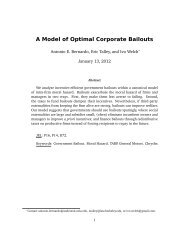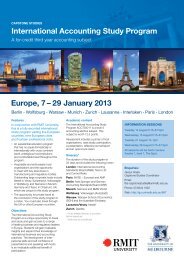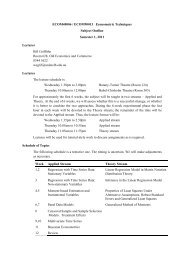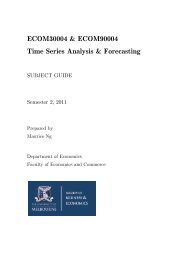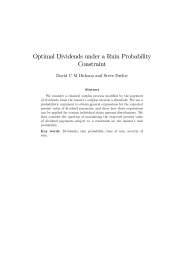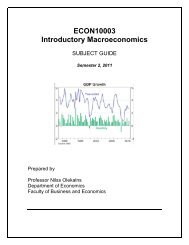Bayesian Inference in the Seemingly Unrelated Regressions Model
Bayesian Inference in the Seemingly Unrelated Regressions Model
Bayesian Inference in the Seemingly Unrelated Regressions Model
Create successful ePaper yourself
Turn your PDF publications into a flip-book with our unique Google optimized e-Paper software.
23<br />
value β<br />
*<br />
is <strong>in</strong>feasible, <strong>the</strong>n r = 0 , and <strong>the</strong> reta<strong>in</strong>ed draw is automatically <strong>the</strong> last<br />
accepted feasible draw. That is,<br />
β<br />
( $ + 1) ( )<br />
= β<br />
$ .<br />
If <strong>the</strong> <strong>in</strong>equality restrictions are not mild, but are l<strong>in</strong>ear, <strong>the</strong>n us<strong>in</strong>g a Gibbs<br />
sampler on subcomponents of β might prove successful. For example, us<strong>in</strong>g <strong>the</strong><br />
truncated multivariate t-distributions for each of <strong>the</strong> β i , as specified <strong>in</strong> equation (46),<br />
could be useful. Also with<strong>in</strong> different contexts, sampl<strong>in</strong>g from truncated multivariate t<br />
and multivariate normal distributions has been broken down <strong>in</strong>to sampl<strong>in</strong>g from<br />
univariate conditional distributions by Geweke (1991) and Hajivassiliou and<br />
McFadden (1990). Also, see <strong>the</strong> Appendix.<br />
VII.<br />
THREE APPLICATIONS<br />
A. Wheat Yield<br />
In Griffiths et al (2001) <strong>the</strong> follow<strong>in</strong>g model was used for predict<strong>in</strong>g wheat yield <strong>in</strong><br />
five Western Australian shires.<br />
2 3 2 2 2<br />
t 1 2 3 4 5 t 6 t 7 t 8 t 9 t 10 t t<br />
Y = β + β t+ β t + β t + β G + β G + β D + β D + β F + β F + e (47)<br />
Yield ( Y t ) depends on a cubic time trend to capture technological change and on<br />
quadratic functions of ra<strong>in</strong>fall dur<strong>in</strong>g <strong>the</strong> germ<strong>in</strong>ation period ( G t ) , <strong>the</strong> development<br />
period ( D t ) , and <strong>the</strong> flower<strong>in</strong>g period ( F t ). The ra<strong>in</strong>falls are measured relative to<br />
<strong>the</strong>ir sample means. Inequality restrictions are imposed to ensure that <strong>the</strong> response of<br />
yield to ra<strong>in</strong>fall, at average ra<strong>in</strong>fall, is positive. That is, for germ<strong>in</strong>ation ra<strong>in</strong>fall, for<br />
example, ∂Y<br />
/ ∂ G =β 5+ 2β 6 > 0. Thus, <strong>the</strong> feasible region for this example is<br />
{ }<br />
S( β ) = β | β + 2β > 0, β + 2β > 0, β + 2β > 0<br />
(48)<br />
5 6 7 8 9 10



